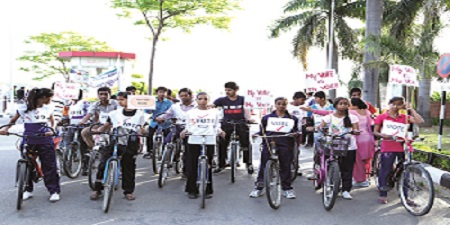
Global Knowledge Network On Voter Education - learning from each other

i. Gender gap
ii. Youth disconnect
iii. Urban apathy
Accordingly overcoming the ‘Youth Disconnect’ with the electoral process was one
of the focus of SVEEP programme. Various interventions were designed around the
youth, with additional gender focus within this segment, to remove any information
gap and to facilitate youth participation in elections. Motivational campaigns were
taken up to mobilise youth and encourage them to register in the electoral roll
and vote in elections.
In 2011, ECI initiated a practice to celebrate the ‘Voter’ on its foundation day, 25th January by celebrating it as National Voters’ Day. Since then the foundation day of ECI is observed every year as National Voters’ Day in every polling station location, at district and state headquarters. With the aim to give the younger generation a sense of responsible citizenship and to encourage them to exercise their new franchise, ECI felicitates the newly eligible registered voters in over 0.7 million polling station locations as part of the National Voters’ Day observance. They are handed over their Elector Photo Identity Cards (EPIC) and a badge with the slogan “Proud to be a Voter-Ready to Vote”. They also take an oath to strengthen democracy by taking part in the elections, which is now popularly termed as NVD Pledge. This forms the essential components of any NVD celebration. The national NVD function is held at New Delhi. Besides the three essential components, the national function also awards election officials for ‘Best Electoral Practices’. Partners and agencies who contribute to ECI’s efforts towards holding free, fair and participative elections are also felicitated at the national NVD function every year. The National Voters’ Day is being celebrated with great enthusiasm across the country along with a series of outreach measures ahead of NVD like symposiums, cycle rally, human chain, folk arts programmes, mini-marathon, competitions and awareness seminars. Most of these activities are targeted at youth.
Campus Ambassadors
Campus Ambassadors are appointed from among the students in Colleges and Universities
to bridge the gap in youth electoral participation. The Campus Ambassadors identify
students, teachers and non-teaching staff and their family members who are not registered
in the electoral rolls and facilitate their registration in the Electoral roll in
co-ordination with the election machinery. They assist election machinery to organize
special drive for registration including correction of errors, transposition of
names etc in the electoral roll. Campus Ambassadors facilitate inclusion of voter
education in various co-curricular activities /festivals of the campus through different
activities such as slogan writing, poster making, quiz, debate, essay writing, song,
street plays etc and also help in organising National Voters’ Day programme in their
campus besides acting as an educator and motivator in the family and neighbourhood
and helping them in filling registration forms.
Engaging with Educational Institutions
Chief electoral Officers in the states have partnered with educational institutions,
mainly colleges and Universities to reach out to the youth. College festivals, marathon
runs, competitions like debates, plays, song composition etc have been successfully
used to engage with students and disseminate electoral information among them. Special
registration camps have been held in campuses to target newly eligible and young
voters.
Partnership with Ministry of Youth and Departments
For reaching out to youth outside educational institutions, ECI has partnered with
the Ministry of Sports and Youth Affairs and engaged various youth organizations
affiliated with the Ministry. Special activities are planned with the youth organization
for wide dissemination of information relating to electoral process. Special registration
drives are held to include the youth outside educational institutions in the electoral
roll. Sports competition in both rural and urban areas is among the popular activities
taken up for engaging with these youth.
Use of popular media including FM Radio
Cinema slides, TV spots, hoardings have been widely used to appeal to youth. Besides
interactive media like street play, flash mobs and similar activities which are
popular among youth have been used to disseminate important information. FM radio
is highly popular among the youth and it has been widely used by election managers
to engage the youth with electoral process. Popular radio programmes and famous
radio jockeys have included electoral awareness in their broadcast. Private FM Radio
channels have held road shows ahead of elections in coordination with election machinery.
Talk shows on radio have featured election officials to discuss various topics related
to elections, interaction with voters have been arranged through phone-ins. Cartoon
strips ‘Wah Election Wah!’ were used in dailies to stir the complacent young urban
non-voters with wit and humour, while also disseminating information of how, where
and when. Set in a train travelling through various parts of the country, the radio
programme ‘Loktantra Express’ is also aimed at youth and uses song and speech, adding
regional flavours to motivate listeners from different regions, age groups and sections
to participate in the task of nation building by practicing their right to vote.
Use of Technology and Social Media
While mobile phone has high penetration in India, youth use the mobile phones for
accessing various services besides just making calls. Special apps have been developed
to facilitate voters and make enrolment easier besides accessing other information
related to elections like locating polling stations, checking names on voter list
besides getting SMS alerts for registration and voting. Other popular media like
internet and social media are widely used for imparting electoral education and
information and for mobilising young voters.
Physical Events and Activities
A variety of physical events and activities are taken up under SVEEP for motivation
and mobilisation. Competitions like drawing, debates, declamations, quiz in educational
institutions on elections and voting enthuse young people. Activities like local
and folk art competitions are used for targeting young rural populace. Song writing
competitions and Rock festivals in public places interest urban youth. Sporting
events like kite flying, motor rallies, cricket tournaments, wrestling events, marathon
runs, mass mobilisation events like rallies, human chains, and candle light vigils
are utilized with good effect. Mock polls and dummy polling stations are effectively
used to engage young people.
Icons
The task of enthusing and inspiring the disinterested and alienated citizens and
address their apathy and skepticism to make possible their participation in the
electoral process is imperative for greater electoral participation. It is crucial
to associate a sense of pride with the right and duty of exercising one’s franchise.
Identifying the ability of inspirational personalities to establish authentic connection
with the masses, ECI associated with renowned Indians from various field enjoying
national appeal and appointed them as ECI’s National Icons to motivate Voters. Similarly
renowned individuals in states were appointed as State Icons. Celebrities popular
among youth have been engaged by ECI to be ambassadors or Icons to motivate youth
to participate in electoral process. While former President of India Dr A P J Abdul
Kalam who had mass appeal, could reach out pan India, sportsperson like M S Dhoni
appealed to youth. Olympiad Saina Nehwal and Marykom are youth icons and especially
had appeal among women. Actor Aamir Khan promoted informed and ethical voting message
of ECI for clean elections.
Electoral literacy for Young Adults


Prospective or future voters
Under the third phase of the Systematic Voters’ Education and Electoral Participation
programme (SVEEP-III), one of the important target segments is prospective voters.
These are the young people falling within the 15-17years age group and who are on
the threshold of adulthood. Special interventions have been conceived to inculcate
electoral literacy among young people through curricula and co-curricula in Schools.
Special interventions are simultaneously planned for those in the same age-group
and outside schools. The theme for 7th National Voters’ Day (NVD) is ‘Empowering
Young and Future Voters’ and the same is the focus of ECI in the year 2017.
Electoral Literacy through Schools
State level Committees were set up in 2016 to assess the electoral literacy component
in school curriculum and suggest additions, wherever required. The Committees have
representation from State Education Board and election officials besides experts.
A national working group has been set up which consists of members from Education
Department, Academics, CSO working in the field of education, Experts and Election
Officials to chalk out co-curricula content and activities on electoral literacy,
which can be suitably included in schools and adapted to impart awareness among
those outside schools.
Interactive School Engagement



Electoral Literacy for those outside Schools
The production and distribution of voter edutainment material for continuous education
in an interesting and comprehensive manner was taken up in collaboration with United
Nations Development Programme (UNDP) in 2013. Focusing on consistent education and
motivation, this project also takes from the concept of pyscho-social learning.
After studying and identifying potential target group for each tool in the initial
stage, a field test of the tools was also done to assure their effectiveness. Frequently
asked questions (FAQ) related to the electoral process and other topics are pictorially
depicted and discussed through the story of the brother-sister duo of Abha and Abhay
in the colourful and easy-to-understand picture book ‘Garv se banein Matdata’, meant
largely for new and semi literates, women and children. The board games ‘Vote Ki
Baazi’ and ‘Ready Steady Vote’ designed upon the traditional board games using folk
art and motifs but with the twist of voter education, imparts education in an interesting
and engaging way.
Stories in Popular Children’s Magazines
Aiming at engaging the to-be voters and to catch them young, specific stories on
voter education were taken up in popular children’s magazines Tinkle and Lotpot.
While in Tinkle the trope of the jungle was used, popular characters Motu & Patlu
appeared discussing voting related topics in Lotpot, in a pictorial, colourful and
interesting way of cartoon-strip format to attract the readers. The initiative aimed
at long term effect of motivating and encouraging children and youth for greater
participation in voting.
Umesh Sinha
Editor-in-Chief, VOICE International
and Member Secretary, VoICE.NET